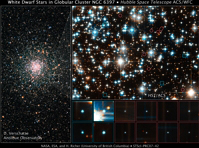A Dying Kick for Stars Like Our Sun?
8 Jan, 2008 11:20 am
The explosive deaths of massive stars can catapult stellar remnants through space with a violent kick. But astronomers thought less massive stars, such as our Sun, were more sedate in their demise. Now, close inspection of a nearby star cluster has revealed these stars may also get a punt when they die, raising questions about the fate of our solar system.
The discovery could provide clues to a long-standing mystery: the puzzling shortage of white dwarfs in loosely bound open star clusters, first noticed by astronomer Volker Weidemann in 1977.
Scientists have speculated the missing dwarfs might have been knocked out of the cluster when they emerged from their parent stars. According to recent theoretical models, a small kick of several kilometers per second would be enough to eject almost all of an open cluster’s white dwarfs into deep space.
The research team focused on a tightly bound globular cluster, where white dwarfs might be trapped by the cluster’s strong gravitational pull. Cluster NGC 6397 is one of the closest globular star clusters to Earth and a popular target for astronomical observations.

But many of the faintest white dwarfs in the cluster eluded detection until NASA installed two new Hubble cameras: the Wide Field and Planetary Camera 2 in 1993 and the Advanced Camera for Surveys in 2002.
Using images from both cameras, the team tracked 84 white dwarfs in a southeast section of the cluster. White dwarfs are like cosmic clocks that cool and dim with time, so the scientists estimated their ages based on color and brightness. They identified 22 young white dwarfs, less than 800 million years old, and 62 older dwarfs between 1.4 and 3.5 billion years old.
The team then used other stars in the cluster as a “ruler” to check the positions of the white dwarfs. In globular clusters, heavier stars tend to gather near the center, while lighter stars drift toward the periphery. Older white dwarfs obeyed this model, lining up with other stars of similar mass.
Since young white dwarfs recently emerged from relatively massive stars – about four-fifths the mass of the Sun – they should still be bunched around the center with the cluster’s current heavyweights. Instead, the scientists found them exiled to the cluster’s outskirts.
This odd placement could mean white dwarfs lose mass in a lopsided way when they form, suggests astronomer and team member Harvey Richer. White dwarfs form when stars similar to our Sun shed their gaseous envelopes. More mass might blow off in one direction than another, Richer says, producing a rocket-like boost that accelerates the star to the edges of the cluster.
The speed of the kick is relatively modest: an estimated 3 to 5 kilometers per second. By comparison, supernova explosions can propel neutron stars, the heavier cousins of white dwarfs, at hundreds of kilometers per second.
Still, the blast could be enough to jolt planets around the stars into different orbits, according to new theoretical models. A tweak to one planet’s path could eject smaller planets from the solar system entirely, says theorist Jeremy Heyl, who reported possible consequences of the kicks in the December 2007 issue of the Monthly Notices of the Royal Astronomical Society: Letters.
If our Sun gets a kick when it becomes a white dwarf in about 5 billion years, Heyl suggests, it could render the final solar system more unstable. Astronomers already expect planets to expand their orbits when the Sun loses mass in the final stages of its life. But a dying kick might also change the shape, not just the size, of these orbits, Heyl says.
The discovery shows there’s still a great deal to learn about how stars die, says Lars Bildsten, an astrophysicist at the University of California, Santa Barbara who was not associated with the study. Although the effect has only been observed in one globular cluster, Bildsten notes, it could open a new line of research investigating how and when these stars get their kicks.
Image Caption:
In a Hubble survey of star cluster NGC 6397, astronomers expected the youngest white dwarfs (in blue squares) to be closer to the cluster’s center than older white dwarfs (in red circles) but instead found them relegated to the edges. Credit: NASA, ESA, and Harvey Richer (University of British Columbia).
References:
Davis DS, Richer HB, King IR, Anderson J, Coffey J, Fahlman GG, Hurley J, Kalirai JS. “On the radial distribution of white dwarfs in the globular cluster NGC 6397.” Monthly Notices of the Royal Astronomical Society: Letters 383.1 (2008): L20-L24.
Heyl, J. “Orbital evolution with white-dwarf kicks.” Monthly Notices of the Royal Astronomical Society: Letters 382.2 (2007): 915-920.
-
05/12/07
Just Plain Weird: An Odd Star Proves to Be a New Type of Object
-
29/10/07
Ad Astra! News and Discoveries from the the Cassini-Huygens Mission to Saturn
-
12/10/07
Late Stages of Planetary System Evolution: the Case of V 391 Peg b
-
16/04/07
Video : Emission Spectra of Extrasolar Planets
-
22/03/07
Another "First": Emission Spectra of Extrasolar Planets






